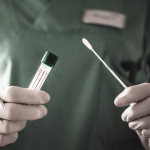A new study from a Veterans Affairs (VA) HIV clinic in Miami found that instituting widespread anal cancer screening among its HIV-positive patients was not only feasible but also justified—it detected a high rate of both precancerous lesions as well as two cases of anal cancer. Though researchers are still working to prove the value of screening, and the best methods to use, this new study, published April 1 in AIDS Patient Care and STDs, lends further weight to those arguing that such screening is both possible and necessary.
Anal cancer rates are swiftly increasing in people with HIV as they live longer thanks to potent combination antiretroviral (ARV) therapy. Between the early 1990s and early 2000s, the rate of diagnosis of anal cancer among people with HIV increased more than threefold.
Despite these alarming rates, however, experts have remained divided about the best way to respond. Some have argued that data on the validity of the current methods used to screen for cancer are inconsistent, that these methods are expensive and complicated to administer, and that even though cancer rates are rising, they are still relatively low overall. What’s more, they further point out that no long-term controlled study has yet proved that treating precancerous lesions significantly reduces the risk of progression to anal cancer.
Other experts counter these arguments by pointing out that all available data strongly suggest that early treatment of anal lesions is highly likely to have similar benefits to treating cervical lesions in women, which substantially reduces the risk of progression to cervical cancer. Moreover, they predict that with the extremely high rates of precancerous lesions among all people with HIV, combined with the dramatic and continued rise in new cases of anal cancer among people with HIV, waiting for a long-term study could mean allowing hundreds of people to progress to anal cancer when they might have been spared.
To help assess the feasibility of implementing an anal cancer screening protocol in an HIV clinic—and to determine the rates of both precancerous and cancerous lesions in a clinic that includes both people who do and do not have a history of anal sex—Isabella Rosa-Cunha, MD, from the University of Miami, and her colleagues, offered anal cancer screening to 160 men enrolled in the VA Medical Center HIV clinic between February and July of 2006. In all, 131 agreed to enter the study.
Staff at the clinic were trained in two screening techniques: the collection of rectal and anal cells with a swab (Pap smear) and the use of a high-resolution scope to view and biopsy abnormal lesions detected by the Pap smears.
The age of the participants ranged from 29 to 80, with most being around 49. Just over half were black, and about 15 percent were Latino. Forty percent reported a history of anal sex. Most were sexually active, and just over half had a history of a sexually transmitted infection (STI). Though 75 percent were on ARVs, 43 percent had a CD4 below 350.
Of the 131 who agreed to participate, 33 had insufficient cells from their Pap smear and so were excluded from further analysis. Among the 98 subjects with adequate cell samples, 52 percent had abnormal cells present. Of those, more than half had cells that required further investigation by high-resolution anoscopy (HRA).
Of the 33 participants who had HRA conducted, precancerous lesions were detected in all but two. More than half had more serious precancerous lesions, and two had cancerous lesions. This meant that nearly 15 percent of the entire clinic cohort had serious precancerous or cancerous lesions, demonstrating the need for screening.
Interestingly, a history of anal sex was in no way associated with the likelihood of having atypical cells or with the likelihood of having serious precancerous or cancerous lesions. The authors acknowledge that because they relied on participant self-report these results could be skewed, however. The only factor that did significantly increase the risk of having a more serious lesion or cancer was having a low CD4 count.
Though the clinic demonstrated that screening was feasible, they did have a high number of Pap smears without useable cells (25 percent), compared with other similar studies, where the rate of such unusable samples is typically well below 8 percent. Rosa-Cunha and her team attributed this to the fact that most of the staff were unfamiliar with the procedures before they were trained, which occurred just before the study got started. Other studies and demonstration projects have also found that the accuracy and skill of health care providers to conduct anal screenings increase significantly with experience.
“A study such as ours demonstrates the feasibility of anal Pap smear screening in routine HIV care that makes possible the early detection of precancerous and even cancerous lesions,” the authors state. “Our results indicate the need for authoritative answers regarding anal dysplasia screening, which in turn should act as a stimulus for further research.”
The authors conclude: “Until there is a consensus regarding anal Pap smear screening, HIV-infected patients need to know they are at risk of anal cancer, and anal health should be an issue of priority for HIV care providers to discuss with their HIV-positive patients.”
Advertisement
Advertisement
Advertisement






3 Comments
3 Comments